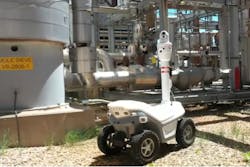OTC 2022 featured tech designed for the future offshore marketplace
By Ariana Hurtado
HOUSTON — The Offshore Technology Conference (OTC) provides ample opportunity to share and soak in new technical and scientific knowledge about offshore energy. Many attendees find themselves gravitating toward the latest in technology innovations showcased on the exhibition floor, and exhibitors, presenters and attendees alike have almost endless conversations about new technology advances and trends.
This year’s conference featured plenty of new technologies, tools and services, and below is a sampling of the latest innovations that were highlighted at the show.
Autonomous operations
Wood and Xplorobot showcased robotic technology that is part of their autonomous operations initiative, which aims to reduce methane emissions for their clients and catch operating anomalies within plants, facilities and assets. The partners shared the results of their successful onshore pilot and ongoing offshore pilot at the conference. They also highlighted video renderings that had been captured from different sites, which provided viewers with a good sense of the types of thermal, acoustic and methane emissions imagery that can be picked up in the field.
“We have successfully deployed autonomous robots onshore and proven the use cases for technology to map visual, thermal, acoustic and vibration process conditions, as well as detect methane leaks,” Paul Leonard, president of Operations Americas with Wood Plc, told Offshore Magazine. “With funding from the Canadian Province of Newfoundland and Labrador, we will be evaluating this technology offshore in the coming months. We are looking forward to implementing this offering further with our clients to optimize their operations and reduce emissions.”
Enhancing lockdown capacity
The industry has to be mindful of operational rig and capex costs and the impact it has on margins. Helping reducing capex costs, Baker Hughes’ MS-2 Annulus Seal will save operational rig costs as the technology reduces one additional rig trip, enhancing lockdown capacity of the wellhead. The technology is designed to drive efficiency savings.
“Typically, the industry practice is to run an additional lockdown hanger, which increases the number of trips and, consequently, rig time and costs,” according to the company. “The Baker Hughes MS-2 Annulus Seal removes this requirement, saving rig time and increasing rig efficiency.”
The new MS-2 sealing technology is tested to maximum industry standards of 200 cycles with 2 MMlb of lockdown capacity, ensuring life-of-field reliability and seal integrity.
“The MS2 features are based on full utilization of smart technology solutions for our offshore customers,” Romain Chambault, vice president services and offshore for Oilfield Equipment with Baker Hughes, told Offshore Magazine. “The MS wellhead guarantees seal installation at full capacity and guarantees full lockdown capacity. Working with our customers, we have developed a wellhead solution that goes beyond API qualification in the offshore industry, a very proud development giving our customers increased operational and installation enhancements.”
Valves for emissions control
The industry is increasingly focused on reducing methane emissions. As of November 2021, nearly 90 countries have committed to the Global Methane Pledge, an initiative to reduce global methane emissions by at least 30% from 2020 levels by 2030.
“As one of the largest contributors of industrial emissions of methane, all eyes will be on the oil and gas industry to deliver, making it imperative that all operators take urgent steps to eliminate fugitive emissions, effectively, reliably and as soon as possible,” Oxford Flow shared with Offshore Magazine.
The pressure equipment control provider said the most common failure points of most valves is the stem and actuator.
“Operators remain trapped in a cycle of spending millions in maintenance to catch leaks after they’ve already increased safety risk or impacted the environment,” according to a November 2021 Oxford Flow news release.
The company’s new ES valve offers a solution for isolation, flow control and pressure reduction, eliminating the potential for fugitive methane emissions.
“Poorly monitored and controlled fugitive emissions from valves contribute significantly to climate change,” Oxford Flow CEO Neil Poxon told Offshore. “We have removed the stem from our ES valve, the primary cause of fugitive emissions.”
Poxon added that the ES valve can play a crucial role in tackling emissions.
Simultaneous casing and drilling
Benthic, a brand within Acteon’s Geoservices segment, recently released its fifth-generation portable, remotely operated drill called PROD5. The system is designed for shallow-water wind developments and offers almost twice the tool load of previous PRODs.
PROD5 is designed to increase productivity and cut costs for the offshore renewable energy industry. Its new functionality includes a drill enhancement package (DEP) suitable for shallow-water and deepwater operations. The DEP enables simultaneous casing and drilling to ensure the borehole is always supported.
First deployment is expected in third-quarter 2022.
“Traditionally, a geotechnical drilling tool would push cone penetration tests (CPT) into the borehole until refusal, then pull out and case,” an Acteon representative shared with Offshore Magazine. “There was a risk of the hole collapsing during pull-out. The DEP allows to move the casing independently of the CPT, always protecting the borehole.”
This one feature will provide higher daily productivity than has previously been the case as well as reduced day-to-day variability.
There are other seabed drills, which have a sweet spot of 1,100 m or so. The company said this new tool allows it to remain competitive on productivity in shallow water and challenging soils.
“The target market for this tool is for offshore wind, where water depths are relatively shallow, generally less than 70 m,” according to the company. “And to succeed in this market, this radical new functionality has been developed.”
This tool can also perform up to 4,000 m.
05.05.2022
About the Author
Ariana Hurtado
Editor-in-Chief
With more than a decade of copy editing, project management and journalism experience, Ariana Hurtado is a seasoned managing editor born and raised in the energy capital of the world—Houston, Texas. She currently serves as editor-in-chief of Offshore, overseeing the editorial team, its content and the brand's growth from a digital perspective.
Utilizing her editorial expertise, she manages digital media for the Offshore team. She also helps create and oversee new special industry reports and revolutionizes existing supplements, while also contributing content to Offshore's magazine, newsletters and website as a copy editor and writer.
Prior to her current role, she served as Offshore's editor and director of special reports from April 2022 to December 2024. Before joining Offshore, she served as senior managing editor of publications with Hart Energy. Prior to her nearly nine years with Hart, she worked on the copy desk as a news editor at the Houston Chronicle.
She graduated magna cum laude with a bachelor's degree in journalism from the University of Houston.



